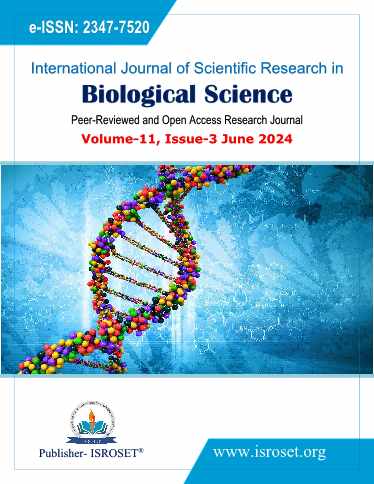Unveiling the Bacterial Diversity of Non-venomous Snakes: Insights from 16S rRNA Gene Sequencing and Phylogenetics
Keywords:
Snakebite, Non-venomous snakes, Oral bacteria, Pathogens, Secondary infections, Central IndiaAbstract
India experiences a high burden of snakebite fatalities, with secondary wound infections posing a significant additional threat. This study investigated the diversity of oral bacteria, including both pathogenic and non-pathogenic species, in the common non-venomous Indian rat snake (Ptyas mucosa) from Central India. Oral swabs were collected for bacterial isolation, followed by DNA extraction and bacterial identification via 16S rRNA gene amplification. All isolates were identified to the strain level, with their consensus sequences deposited in the NCBI Gen Bank database. Phylogenetic trees were generated using MEGA X software. We identified eight bacterial strains: Enterococcus faecalis strain yjd-wu, Lysinibacillus capsici strain PB300, Lysinibacillus fusiformis strain 24, Lysinibacillus macroides strain R154, Mammaliicoccus sciuri strain A-SD13, Mammaliicoccus sciuri strain FDAARGOS_285, Mesobacillus subterraneus strain HBPPPL1, and Mesobacillus subterraneus strain KI1. Among these, two strains were highly pathogenic to humans, and two were moderately pathogenic. Findings of the study show the presence of harmful bacteria in the oral cavity of non-venomous snakes, implying a risk of subsequent infections and wound problems after snakebite.
References
W. Suraweera, D. Warrell, R. Whitaker, G. Menon, R. Rodrigues, S.F. Hang, “Trends in snakebite deaths in India from 2000 to 2019 in a nationally representative mortality study,” eLife. 9: pp.1-37, 2020. https://doi.org/10.7554/eLife.54076
M.T. Jorge, L.A. Ribeiro, “Infections in the bite site after envenoming by snakes of the Bothrops genus,” Journal of Venomous Animals and Toxins including Tropical Diseases. 3: pp.264-272, 1997. https://doi.org/10.1590/S0104-79301997000200002
B. Mohapatra, D.A. Warrell, W. Suraweera, P. Bhatia, N. Dhingra, R.M. Jotkar, “Snakebite mortality in India: a nationally representative mortality survey,” PLoS Neglected Tropical Disease. 5, 2011. https://doi.org/10.1371/journal.pntd.0001018
H.A. Reid, P.C. Thean, W.J. Martin, “Epidemiology of snake bite in North Malaya,” British Medical journal. 13: pp.992-997, 1963. https://doi.org/10.1136/bmj.1.5336.992
G. Rosenfeld, “Symptomatology, Pathology and Treatment of Snake Bite in South America,” In: W. Bucher and E. Buckley (eds.). Venomous Animals and Their Venoms: Venomous Vertebrates (Vol. 2) Academic Press, New York, pp.346-381, 1971.
S.P. Krishnankutty, M. Muraleedharan, R.C. Perumal, S. Michael, J. Benny, B. Balan, “Next-generation sequencing analysis reveals high bacterial diversity in wild venomous and non-venomous snakes from India,” Journal of Venomous Animals and Toxins including Tropical Diseases. 24: pp.1-11, 2018. https://doi.org/10.1186/s40409-018-0181-8
I.K. Shaikh, P.P. Dixit, B.S. Pawade, M. Potnis-Lele, B.P. Kurhe, “Assessment of cultivable oral bacterial flora from important venomous snakes of India and their antibiotic susceptibilities,” Current Microbiology. 74: pp.1278-1286, 2021. https://doi.org/10.1007/s00284-017-1313-z
M. Lodha, S. Ishaque, “Microbiome analysis from Russell`s viper found in western part of Madhya Pradesh, India,” International Journal of Life Sciences. 6: pp.462-465, 2018.
S.K. Panda, L. Padhi, G. Sahoo, “Oral bacterial flora of Indian cobra (Najanaja) and their antibiotic susceptibilities,” Heliyon. 4: pp.1-15, 2018. https://doi.org/10.1016/j.heliyon.2018.e01008
S.K. Panda, L. Padhi, G. Sahoo, “Evaluation of cultivable aerobic bacterial flora from Russell`s viper (Daboia russelii) oral cavity,” Microbial Pathogenesis. 134: pp.1-7, 2019. https://doi.org/10.1016/j.micpath.2019.103573
L. Padhi, S.K. Panda, P.P. Mohapatra, G. Sahoo, “Antibiotic susceptibility of cultivable aerobic microbiota from the oral cavity of Echiscarinatus from Odisha (India),” Microbial Pathogenesis. 143: pp.1-6, 2020. https://doi.org/10.1016/j.micpath.2020.104121
A. Sarsavan, S. Ishaque, M. Lodha, A. Gupta, “Molecular characterization and genetic evolutionary relationship of Staphylococcus sciuri using 16S rRNA gene sequencing from non-venomous snake checkeredkeelback (Fowlea piscator, Schneider, 1799) from Western Madhya Pradesh, India,” International Journal of Scientific Research in Biological Sciences. 8: pp.96-111, 2021.
J.D. Thompson, D.G. Higgins, T.J. Gibson, “CLUSTAL W: improving the sensitivity of progressive multiple sequence alignment through sequence weighting, position-specific gap penalties and weight matrix choice,” Nucleic Acids Research. 22: pp.4673-4680, 1994. https://doi.org/10.1093/nar/22.22.4673
S.F. Altschul, W. Gish, Miller, E.W. Myers, D.J. Lipman, “Basic local alignment search tool. Journal of Molecular Biology,” 215: pp.403-410, 1990. https://doi.org/10.1016/S0022-2836(05)80360-2
K. Tamura, M. Nei, “Estimation of the number of nucleotide substitutions in the control region of mitochondrial DNA in humans and chimpanzees,” Molecular Biology and Evolution.10: pp. 512-526, 1993. https://doi.org/10.1093/oxfordjournals.molbev.a040023
S. Kumar, G. Stecher, M. Li, C. Knyaz, K. Tamura, “MEGA X: Molecular Evolutionary Genetics Analysis across computing platforms”. Molecular Biology and Evolution. 35: pp.1547-1549, 2018. https://doi.org/10.1093/molbev/msy096
V.T. Daria, J.M. Melissa, S.G. Michael, “Structure, Function, and Biology of the Enterococcus faecalis Cytolysin,” Toxins. 5: pp.895-911, 2013.https://doi.org/10.3390/toxins5050895
M. Burkett-Cadena, L. Sastoque, J. Cadena, C.A. Dunlap, “Lysinibacilluscapsici sp. nov, isolated from the rhizosphere of a pepper plant,” Antonie van Leeuwenhoek, 112: pp.1161-1167, 2019. https://doi.org/10.1007/s10482-019-01248-w
H. Morioka, K. Oka, Y. Yamada, Y. Nakane, H. Komiya, C. Murase, M. Iguchi, T. Yagi “Lysinibacillus fusiformis bacteremia: Case report and literature review,” Journal of Infection and Chemotherapy. 28: pp.315-318, 2022. https://doi.org/10.1016/j.jiac.2021.10.030
A. Samadi, H. Sharifi, Z. N. Ghobadi, S. Yaghmaei, “Biodegradation of Polychlorinated Biphenyls by Lysinibacillus macrolides and Bacillus firmus Isolated from Contaminated Soil,” International Journal of Engineering. 32: pp.628-633, 2019.
E.A. Grice, J.A. Segre, “The skin microbiome. Nature Reviews Microbiology," 9: pp.244-253, 2011. https://doi.org/10.1038/nrmicro2537
S. Kanso, A.C. Greene, B.K.C. Patel, “Bacillus subterraneus sp. nov., an iron- and manganese-reducing bacterium from a deep subsurface Australian thermal aquifer,” International Journal of Systematic and Evolutionary Microbiology. 52: pp.869-874, 2002. https://doi.org/10.1099/00207713-52-3-869
Downloads
Published
How to Cite
Issue
Section
License

This work is licensed under a Creative Commons Attribution 4.0 International License.
Authors contributing to this journal agree to publish their articles under the Creative Commons Attribution 4.0 International License, allowing third parties to share their work (copy, distribute, transmit) and to adapt it, under the condition that the authors are given credit and that in the event of reuse or distribution, the terms of this license are made clear.







